Analysis of Agricultural Subsidies in International Trade HI5016
VerifiedAdded on 2023/01/23
|15
|4098
|38
Report
AI Summary
This report analyzes agricultural subsidies within the context of international trade and enterprise, with a focus on the European Union, United States, and China. The study explores the rationale behind government intervention in the agricultural sector, the types of subsidies provided (including tax reductions, price subsidies, and input support), and their impact on production, competitiveness, and trade. The report examines the positive and negative aspects of agricultural subsidies in each country, considering their effects on commodity exports, global trade patterns, and the welfare of farmers. It discusses the findings related to the impact of subsidies on production, competitiveness, and trade, as well as the effects on farmers and the economy. The report concludes by summarizing the findings and offering comments on the complexities of agricultural subsidies and their implications for international trade.
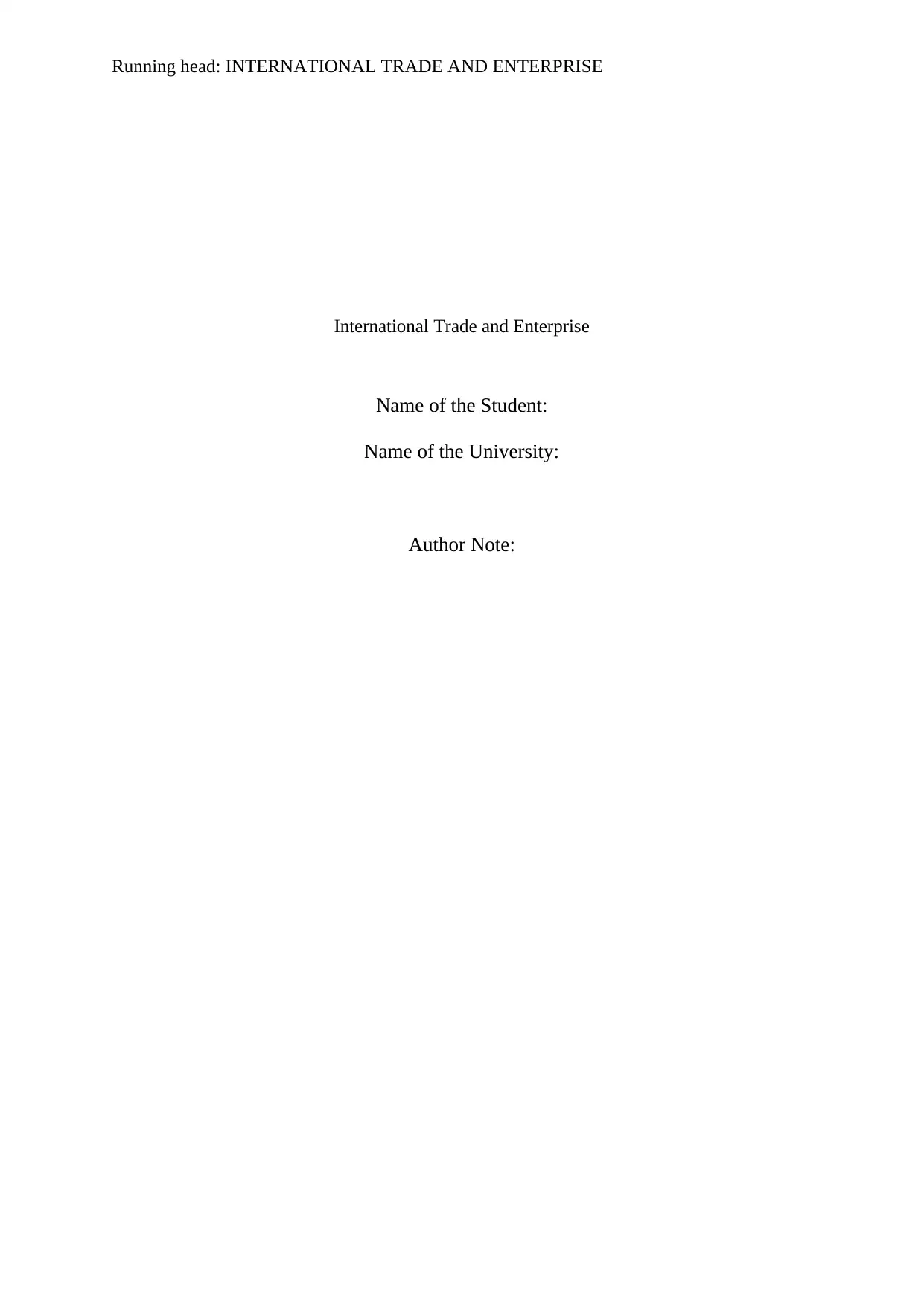
Running head: INTERNATIONAL TRADE AND ENTERPRISE
International Trade and Enterprise
Name of the Student:
Name of the University:
Author Note:
International Trade and Enterprise
Name of the Student:
Name of the University:
Author Note:
Paraphrase This Document
Need a fresh take? Get an instant paraphrase of this document with our AI Paraphraser
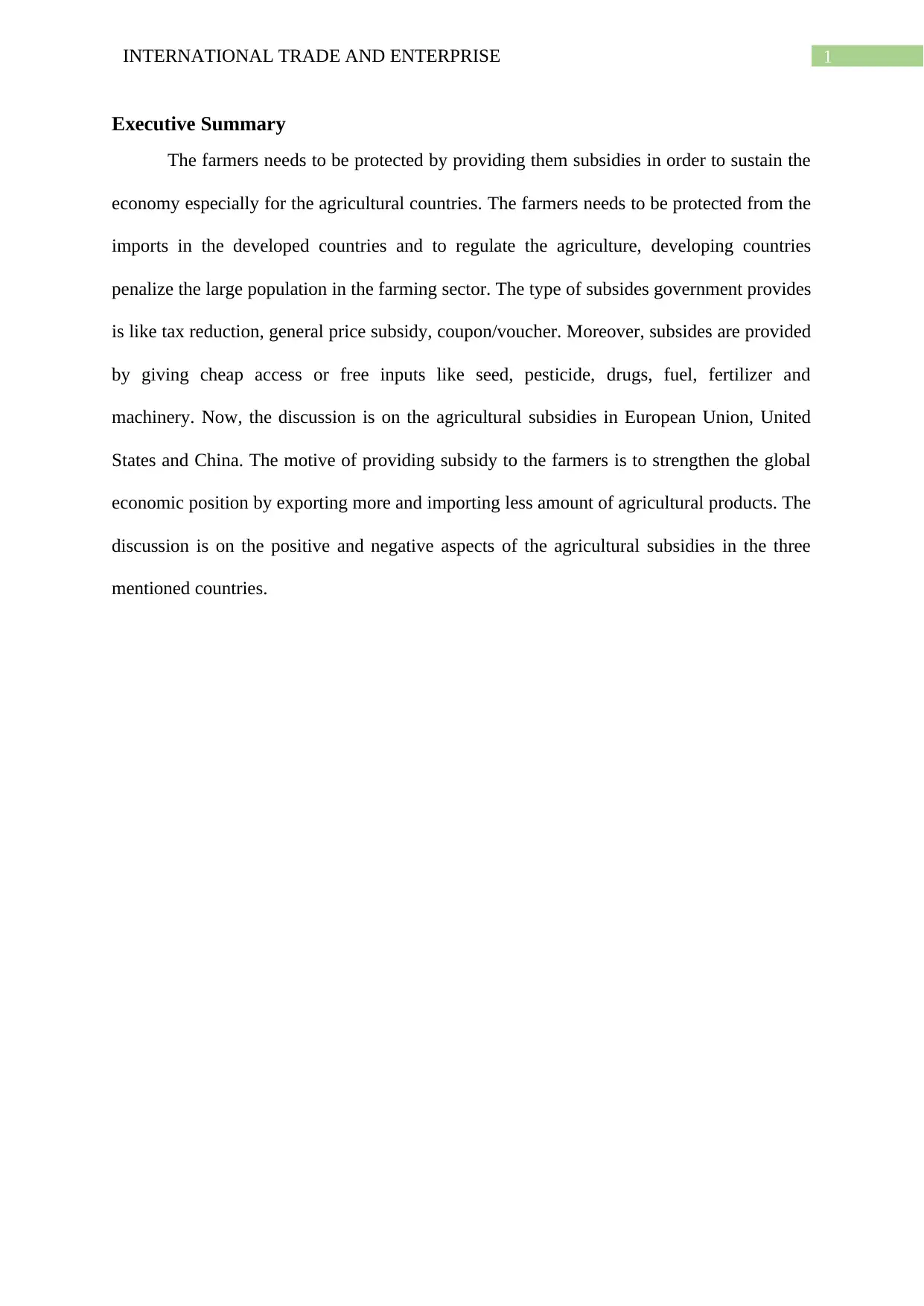
1INTERNATIONAL TRADE AND ENTERPRISE
Executive Summary
The farmers needs to be protected by providing them subsidies in order to sustain the
economy especially for the agricultural countries. The farmers needs to be protected from the
imports in the developed countries and to regulate the agriculture, developing countries
penalize the large population in the farming sector. The type of subsides government provides
is like tax reduction, general price subsidy, coupon/voucher. Moreover, subsides are provided
by giving cheap access or free inputs like seed, pesticide, drugs, fuel, fertilizer and
machinery. Now, the discussion is on the agricultural subsidies in European Union, United
States and China. The motive of providing subsidy to the farmers is to strengthen the global
economic position by exporting more and importing less amount of agricultural products. The
discussion is on the positive and negative aspects of the agricultural subsidies in the three
mentioned countries.
Executive Summary
The farmers needs to be protected by providing them subsidies in order to sustain the
economy especially for the agricultural countries. The farmers needs to be protected from the
imports in the developed countries and to regulate the agriculture, developing countries
penalize the large population in the farming sector. The type of subsides government provides
is like tax reduction, general price subsidy, coupon/voucher. Moreover, subsides are provided
by giving cheap access or free inputs like seed, pesticide, drugs, fuel, fertilizer and
machinery. Now, the discussion is on the agricultural subsidies in European Union, United
States and China. The motive of providing subsidy to the farmers is to strengthen the global
economic position by exporting more and importing less amount of agricultural products. The
discussion is on the positive and negative aspects of the agricultural subsidies in the three
mentioned countries.
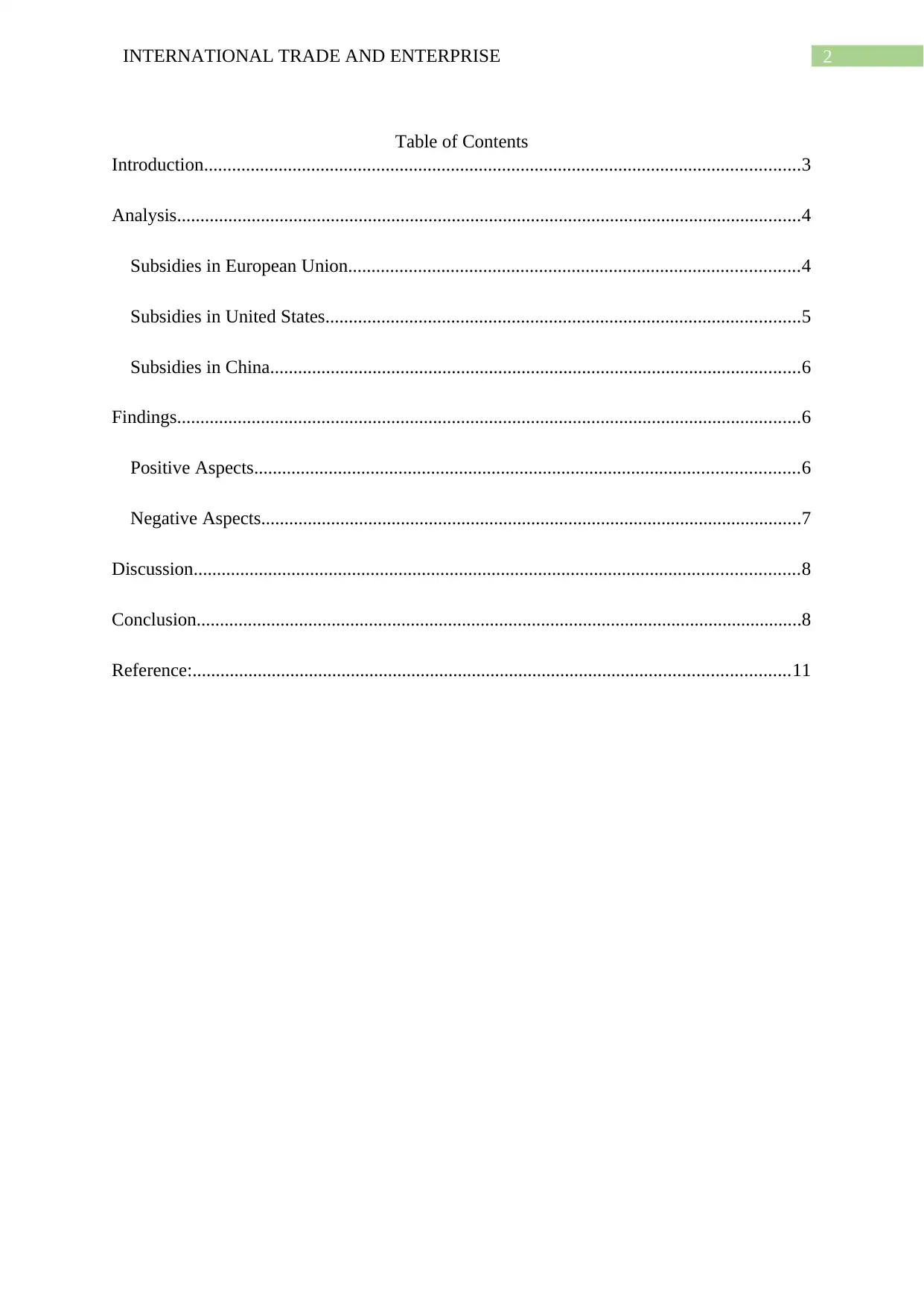
2INTERNATIONAL TRADE AND ENTERPRISE
Table of Contents
Introduction................................................................................................................................3
Analysis......................................................................................................................................4
Subsidies in European Union.................................................................................................4
Subsidies in United States......................................................................................................5
Subsidies in China..................................................................................................................6
Findings......................................................................................................................................6
Positive Aspects.....................................................................................................................6
Negative Aspects....................................................................................................................7
Discussion..................................................................................................................................8
Conclusion..................................................................................................................................8
Reference:................................................................................................................................11
Table of Contents
Introduction................................................................................................................................3
Analysis......................................................................................................................................4
Subsidies in European Union.................................................................................................4
Subsidies in United States......................................................................................................5
Subsidies in China..................................................................................................................6
Findings......................................................................................................................................6
Positive Aspects.....................................................................................................................6
Negative Aspects....................................................................................................................7
Discussion..................................................................................................................................8
Conclusion..................................................................................................................................8
Reference:................................................................................................................................11
⊘ This is a preview!⊘
Do you want full access?
Subscribe today to unlock all pages.

Trusted by 1+ million students worldwide
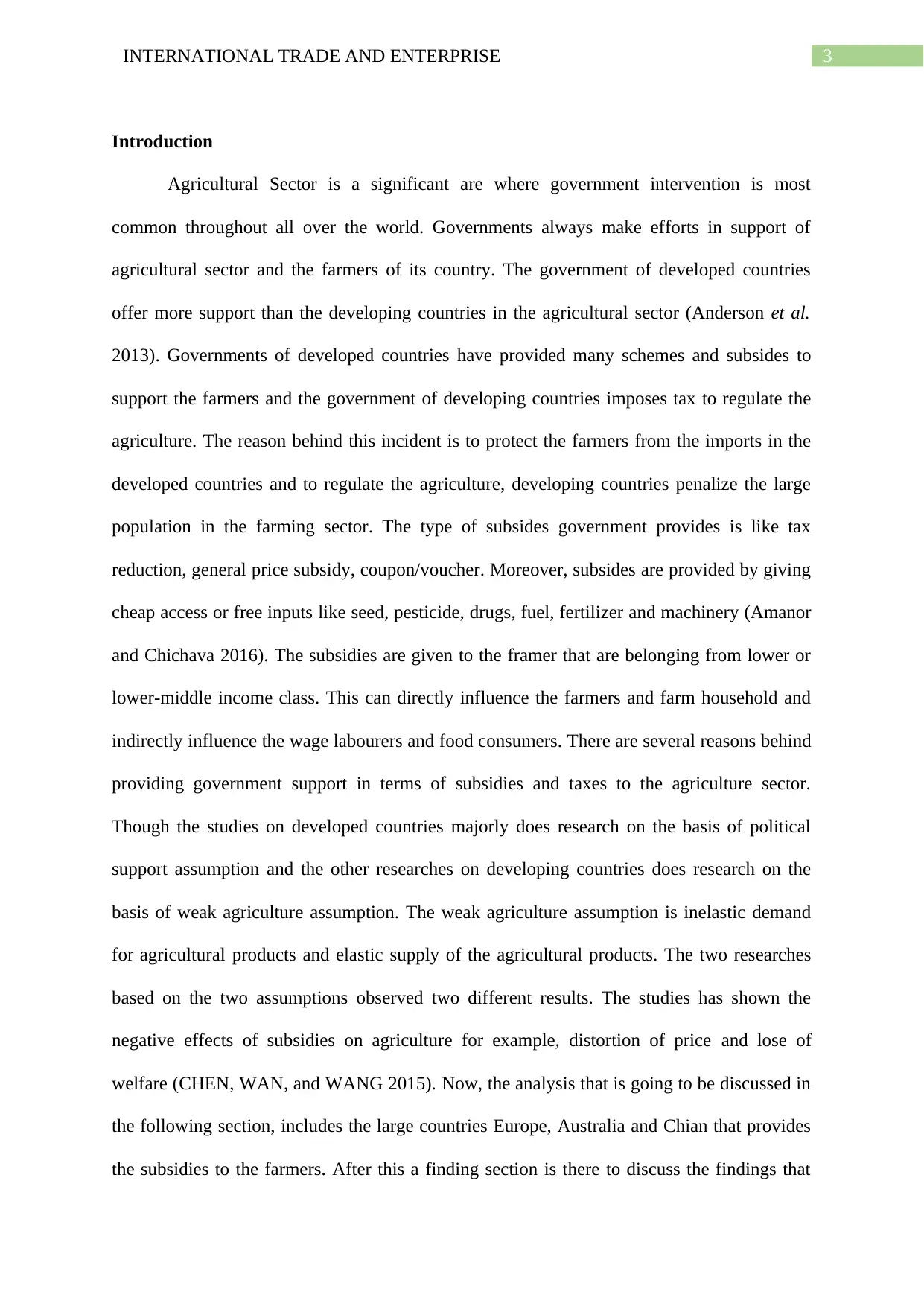
3INTERNATIONAL TRADE AND ENTERPRISE
Introduction
Agricultural Sector is a significant are where government intervention is most
common throughout all over the world. Governments always make efforts in support of
agricultural sector and the farmers of its country. The government of developed countries
offer more support than the developing countries in the agricultural sector (Anderson et al.
2013). Governments of developed countries have provided many schemes and subsides to
support the farmers and the government of developing countries imposes tax to regulate the
agriculture. The reason behind this incident is to protect the farmers from the imports in the
developed countries and to regulate the agriculture, developing countries penalize the large
population in the farming sector. The type of subsides government provides is like tax
reduction, general price subsidy, coupon/voucher. Moreover, subsides are provided by giving
cheap access or free inputs like seed, pesticide, drugs, fuel, fertilizer and machinery (Amanor
and Chichava 2016). The subsidies are given to the framer that are belonging from lower or
lower-middle income class. This can directly influence the farmers and farm household and
indirectly influence the wage labourers and food consumers. There are several reasons behind
providing government support in terms of subsidies and taxes to the agriculture sector.
Though the studies on developed countries majorly does research on the basis of political
support assumption and the other researches on developing countries does research on the
basis of weak agriculture assumption. The weak agriculture assumption is inelastic demand
for agricultural products and elastic supply of the agricultural products. The two researches
based on the two assumptions observed two different results. The studies has shown the
negative effects of subsidies on agriculture for example, distortion of price and lose of
welfare (CHEN, WAN, and WANG 2015). Now, the analysis that is going to be discussed in
the following section, includes the large countries Europe, Australia and Chian that provides
the subsidies to the farmers. After this a finding section is there to discuss the findings that
Introduction
Agricultural Sector is a significant are where government intervention is most
common throughout all over the world. Governments always make efforts in support of
agricultural sector and the farmers of its country. The government of developed countries
offer more support than the developing countries in the agricultural sector (Anderson et al.
2013). Governments of developed countries have provided many schemes and subsides to
support the farmers and the government of developing countries imposes tax to regulate the
agriculture. The reason behind this incident is to protect the farmers from the imports in the
developed countries and to regulate the agriculture, developing countries penalize the large
population in the farming sector. The type of subsides government provides is like tax
reduction, general price subsidy, coupon/voucher. Moreover, subsides are provided by giving
cheap access or free inputs like seed, pesticide, drugs, fuel, fertilizer and machinery (Amanor
and Chichava 2016). The subsidies are given to the framer that are belonging from lower or
lower-middle income class. This can directly influence the farmers and farm household and
indirectly influence the wage labourers and food consumers. There are several reasons behind
providing government support in terms of subsidies and taxes to the agriculture sector.
Though the studies on developed countries majorly does research on the basis of political
support assumption and the other researches on developing countries does research on the
basis of weak agriculture assumption. The weak agriculture assumption is inelastic demand
for agricultural products and elastic supply of the agricultural products. The two researches
based on the two assumptions observed two different results. The studies has shown the
negative effects of subsidies on agriculture for example, distortion of price and lose of
welfare (CHEN, WAN, and WANG 2015). Now, the analysis that is going to be discussed in
the following section, includes the large countries Europe, Australia and Chian that provides
the subsidies to the farmers. After this a finding section is there to discuss the findings that
Paraphrase This Document
Need a fresh take? Get an instant paraphrase of this document with our AI Paraphraser
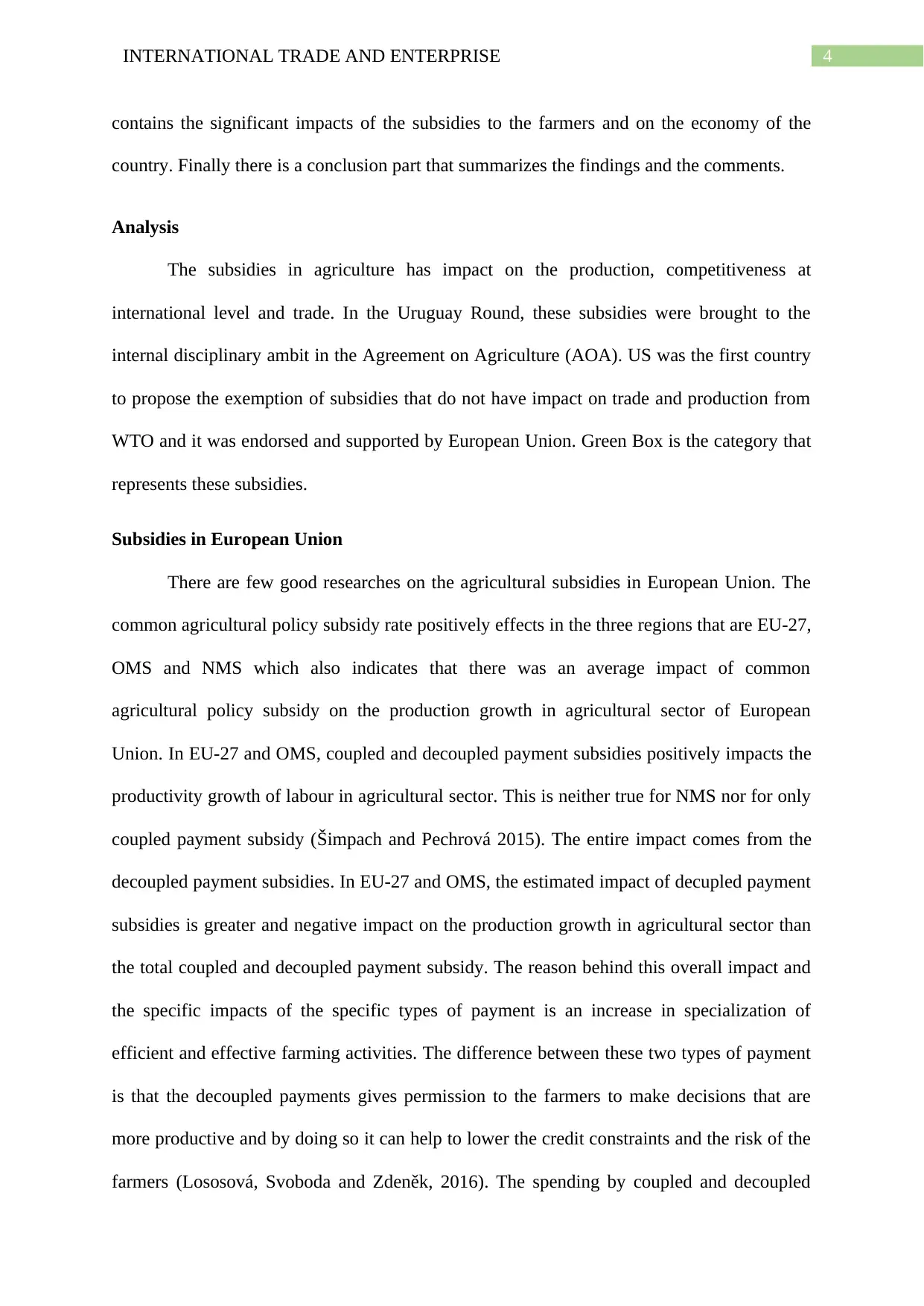
4INTERNATIONAL TRADE AND ENTERPRISE
contains the significant impacts of the subsidies to the farmers and on the economy of the
country. Finally there is a conclusion part that summarizes the findings and the comments.
Analysis
The subsidies in agriculture has impact on the production, competitiveness at
international level and trade. In the Uruguay Round, these subsidies were brought to the
internal disciplinary ambit in the Agreement on Agriculture (AOA). US was the first country
to propose the exemption of subsidies that do not have impact on trade and production from
WTO and it was endorsed and supported by European Union. Green Box is the category that
represents these subsidies.
Subsidies in European Union
There are few good researches on the agricultural subsidies in European Union. The
common agricultural policy subsidy rate positively effects in the three regions that are EU-27,
OMS and NMS which also indicates that there was an average impact of common
agricultural policy subsidy on the production growth in agricultural sector of European
Union. In EU-27 and OMS, coupled and decoupled payment subsidies positively impacts the
productivity growth of labour in agricultural sector. This is neither true for NMS nor for only
coupled payment subsidy (Šimpach and Pechrová 2015). The entire impact comes from the
decoupled payment subsidies. In EU-27 and OMS, the estimated impact of decupled payment
subsidies is greater and negative impact on the production growth in agricultural sector than
the total coupled and decoupled payment subsidy. The reason behind this overall impact and
the specific impacts of the specific types of payment is an increase in specialization of
efficient and effective farming activities. The difference between these two types of payment
is that the decoupled payments gives permission to the farmers to make decisions that are
more productive and by doing so it can help to lower the credit constraints and the risk of the
farmers (Lososová, Svoboda and Zdeněk, 2016). The spending by coupled and decoupled
contains the significant impacts of the subsidies to the farmers and on the economy of the
country. Finally there is a conclusion part that summarizes the findings and the comments.
Analysis
The subsidies in agriculture has impact on the production, competitiveness at
international level and trade. In the Uruguay Round, these subsidies were brought to the
internal disciplinary ambit in the Agreement on Agriculture (AOA). US was the first country
to propose the exemption of subsidies that do not have impact on trade and production from
WTO and it was endorsed and supported by European Union. Green Box is the category that
represents these subsidies.
Subsidies in European Union
There are few good researches on the agricultural subsidies in European Union. The
common agricultural policy subsidy rate positively effects in the three regions that are EU-27,
OMS and NMS which also indicates that there was an average impact of common
agricultural policy subsidy on the production growth in agricultural sector of European
Union. In EU-27 and OMS, coupled and decoupled payment subsidies positively impacts the
productivity growth of labour in agricultural sector. This is neither true for NMS nor for only
coupled payment subsidy (Šimpach and Pechrová 2015). The entire impact comes from the
decoupled payment subsidies. In EU-27 and OMS, the estimated impact of decupled payment
subsidies is greater and negative impact on the production growth in agricultural sector than
the total coupled and decoupled payment subsidy. The reason behind this overall impact and
the specific impacts of the specific types of payment is an increase in specialization of
efficient and effective farming activities. The difference between these two types of payment
is that the decoupled payments gives permission to the farmers to make decisions that are
more productive and by doing so it can help to lower the credit constraints and the risk of the
farmers (Lososová, Svoboda and Zdeněk, 2016). The spending by coupled and decoupled
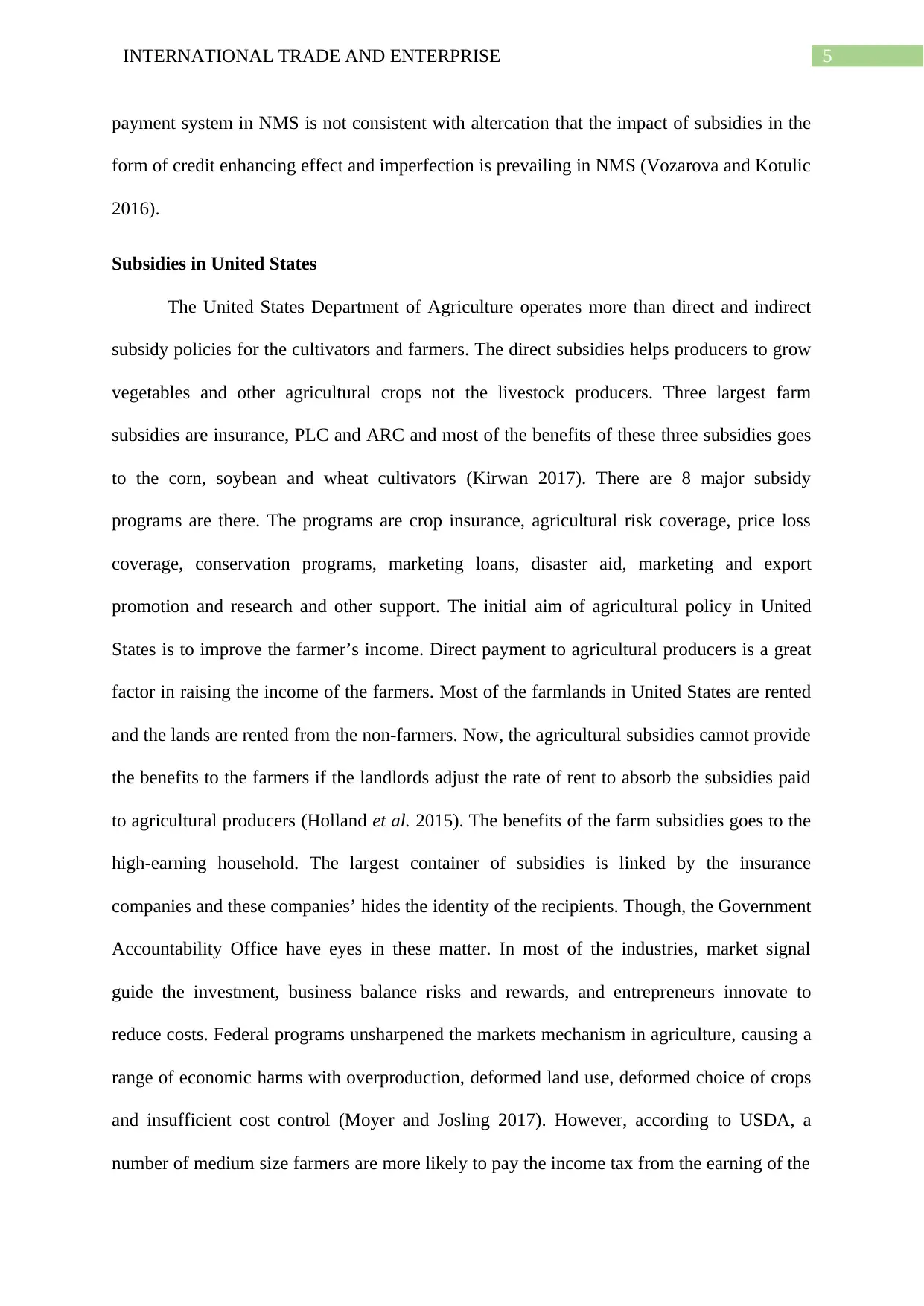
5INTERNATIONAL TRADE AND ENTERPRISE
payment system in NMS is not consistent with altercation that the impact of subsidies in the
form of credit enhancing effect and imperfection is prevailing in NMS (Vozarova and Kotulic
2016).
Subsidies in United States
The United States Department of Agriculture operates more than direct and indirect
subsidy policies for the cultivators and farmers. The direct subsidies helps producers to grow
vegetables and other agricultural crops not the livestock producers. Three largest farm
subsidies are insurance, PLC and ARC and most of the benefits of these three subsidies goes
to the corn, soybean and wheat cultivators (Kirwan 2017). There are 8 major subsidy
programs are there. The programs are crop insurance, agricultural risk coverage, price loss
coverage, conservation programs, marketing loans, disaster aid, marketing and export
promotion and research and other support. The initial aim of agricultural policy in United
States is to improve the farmer’s income. Direct payment to agricultural producers is a great
factor in raising the income of the farmers. Most of the farmlands in United States are rented
and the lands are rented from the non-farmers. Now, the agricultural subsidies cannot provide
the benefits to the farmers if the landlords adjust the rate of rent to absorb the subsidies paid
to agricultural producers (Holland et al. 2015). The benefits of the farm subsidies goes to the
high-earning household. The largest container of subsidies is linked by the insurance
companies and these companies’ hides the identity of the recipients. Though, the Government
Accountability Office have eyes in these matter. In most of the industries, market signal
guide the investment, business balance risks and rewards, and entrepreneurs innovate to
reduce costs. Federal programs unsharpened the markets mechanism in agriculture, causing a
range of economic harms with overproduction, deformed land use, deformed choice of crops
and insufficient cost control (Moyer and Josling 2017). However, according to USDA, a
number of medium size farmers are more likely to pay the income tax from the earning of the
payment system in NMS is not consistent with altercation that the impact of subsidies in the
form of credit enhancing effect and imperfection is prevailing in NMS (Vozarova and Kotulic
2016).
Subsidies in United States
The United States Department of Agriculture operates more than direct and indirect
subsidy policies for the cultivators and farmers. The direct subsidies helps producers to grow
vegetables and other agricultural crops not the livestock producers. Three largest farm
subsidies are insurance, PLC and ARC and most of the benefits of these three subsidies goes
to the corn, soybean and wheat cultivators (Kirwan 2017). There are 8 major subsidy
programs are there. The programs are crop insurance, agricultural risk coverage, price loss
coverage, conservation programs, marketing loans, disaster aid, marketing and export
promotion and research and other support. The initial aim of agricultural policy in United
States is to improve the farmer’s income. Direct payment to agricultural producers is a great
factor in raising the income of the farmers. Most of the farmlands in United States are rented
and the lands are rented from the non-farmers. Now, the agricultural subsidies cannot provide
the benefits to the farmers if the landlords adjust the rate of rent to absorb the subsidies paid
to agricultural producers (Holland et al. 2015). The benefits of the farm subsidies goes to the
high-earning household. The largest container of subsidies is linked by the insurance
companies and these companies’ hides the identity of the recipients. Though, the Government
Accountability Office have eyes in these matter. In most of the industries, market signal
guide the investment, business balance risks and rewards, and entrepreneurs innovate to
reduce costs. Federal programs unsharpened the markets mechanism in agriculture, causing a
range of economic harms with overproduction, deformed land use, deformed choice of crops
and insufficient cost control (Moyer and Josling 2017). However, according to USDA, a
number of medium size farmers are more likely to pay the income tax from the earning of the
⊘ This is a preview!⊘
Do you want full access?
Subscribe today to unlock all pages.

Trusted by 1+ million students worldwide
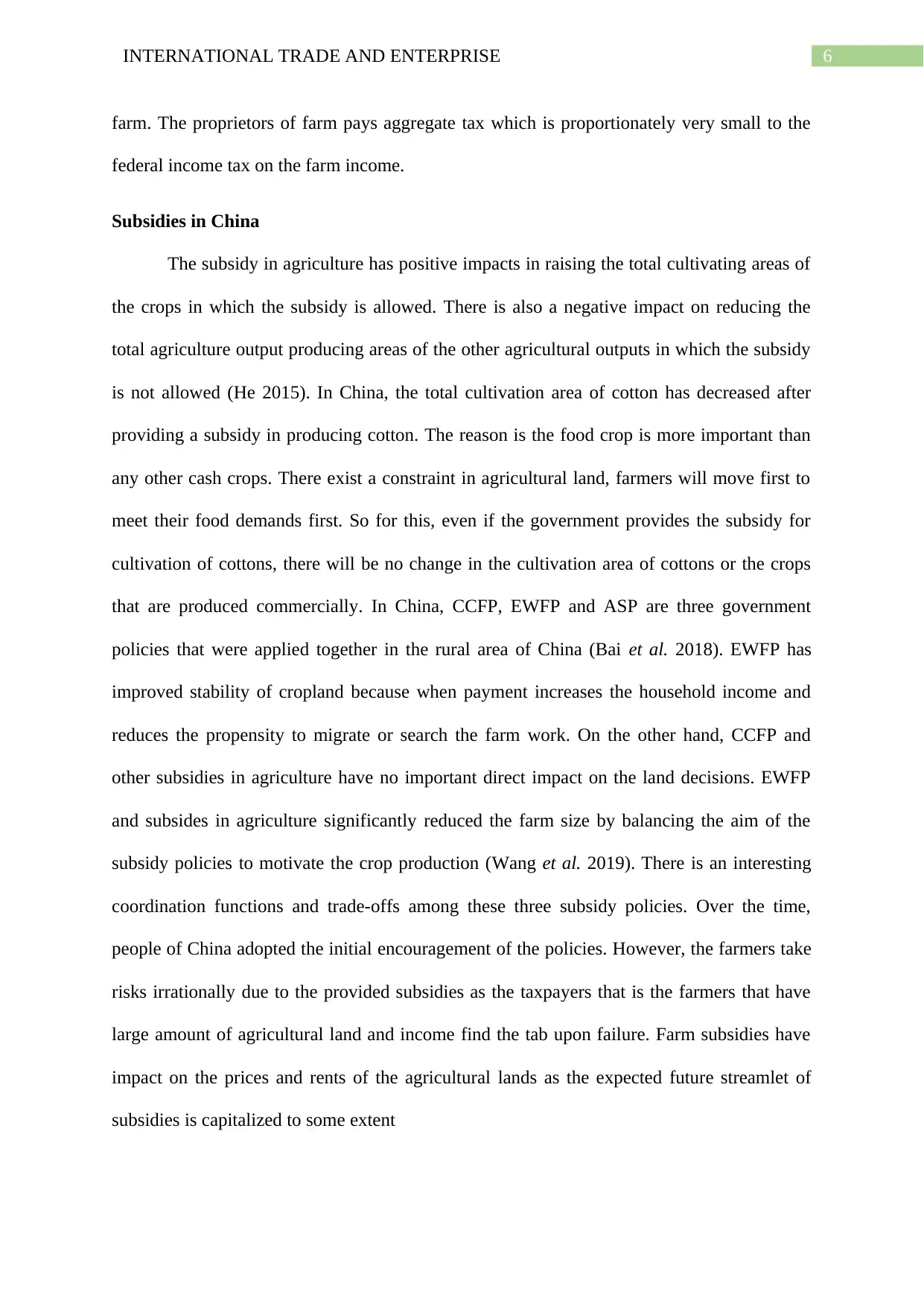
6INTERNATIONAL TRADE AND ENTERPRISE
farm. The proprietors of farm pays aggregate tax which is proportionately very small to the
federal income tax on the farm income.
Subsidies in China
The subsidy in agriculture has positive impacts in raising the total cultivating areas of
the crops in which the subsidy is allowed. There is also a negative impact on reducing the
total agriculture output producing areas of the other agricultural outputs in which the subsidy
is not allowed (He 2015). In China, the total cultivation area of cotton has decreased after
providing a subsidy in producing cotton. The reason is the food crop is more important than
any other cash crops. There exist a constraint in agricultural land, farmers will move first to
meet their food demands first. So for this, even if the government provides the subsidy for
cultivation of cottons, there will be no change in the cultivation area of cottons or the crops
that are produced commercially. In China, CCFP, EWFP and ASP are three government
policies that were applied together in the rural area of China (Bai et al. 2018). EWFP has
improved stability of cropland because when payment increases the household income and
reduces the propensity to migrate or search the farm work. On the other hand, CCFP and
other subsidies in agriculture have no important direct impact on the land decisions. EWFP
and subsides in agriculture significantly reduced the farm size by balancing the aim of the
subsidy policies to motivate the crop production (Wang et al. 2019). There is an interesting
coordination functions and trade-offs among these three subsidy policies. Over the time,
people of China adopted the initial encouragement of the policies. However, the farmers take
risks irrationally due to the provided subsidies as the taxpayers that is the farmers that have
large amount of agricultural land and income find the tab upon failure. Farm subsidies have
impact on the prices and rents of the agricultural lands as the expected future streamlet of
subsidies is capitalized to some extent
farm. The proprietors of farm pays aggregate tax which is proportionately very small to the
federal income tax on the farm income.
Subsidies in China
The subsidy in agriculture has positive impacts in raising the total cultivating areas of
the crops in which the subsidy is allowed. There is also a negative impact on reducing the
total agriculture output producing areas of the other agricultural outputs in which the subsidy
is not allowed (He 2015). In China, the total cultivation area of cotton has decreased after
providing a subsidy in producing cotton. The reason is the food crop is more important than
any other cash crops. There exist a constraint in agricultural land, farmers will move first to
meet their food demands first. So for this, even if the government provides the subsidy for
cultivation of cottons, there will be no change in the cultivation area of cottons or the crops
that are produced commercially. In China, CCFP, EWFP and ASP are three government
policies that were applied together in the rural area of China (Bai et al. 2018). EWFP has
improved stability of cropland because when payment increases the household income and
reduces the propensity to migrate or search the farm work. On the other hand, CCFP and
other subsidies in agriculture have no important direct impact on the land decisions. EWFP
and subsides in agriculture significantly reduced the farm size by balancing the aim of the
subsidy policies to motivate the crop production (Wang et al. 2019). There is an interesting
coordination functions and trade-offs among these three subsidy policies. Over the time,
people of China adopted the initial encouragement of the policies. However, the farmers take
risks irrationally due to the provided subsidies as the taxpayers that is the farmers that have
large amount of agricultural land and income find the tab upon failure. Farm subsidies have
impact on the prices and rents of the agricultural lands as the expected future streamlet of
subsidies is capitalized to some extent
Paraphrase This Document
Need a fresh take? Get an instant paraphrase of this document with our AI Paraphraser
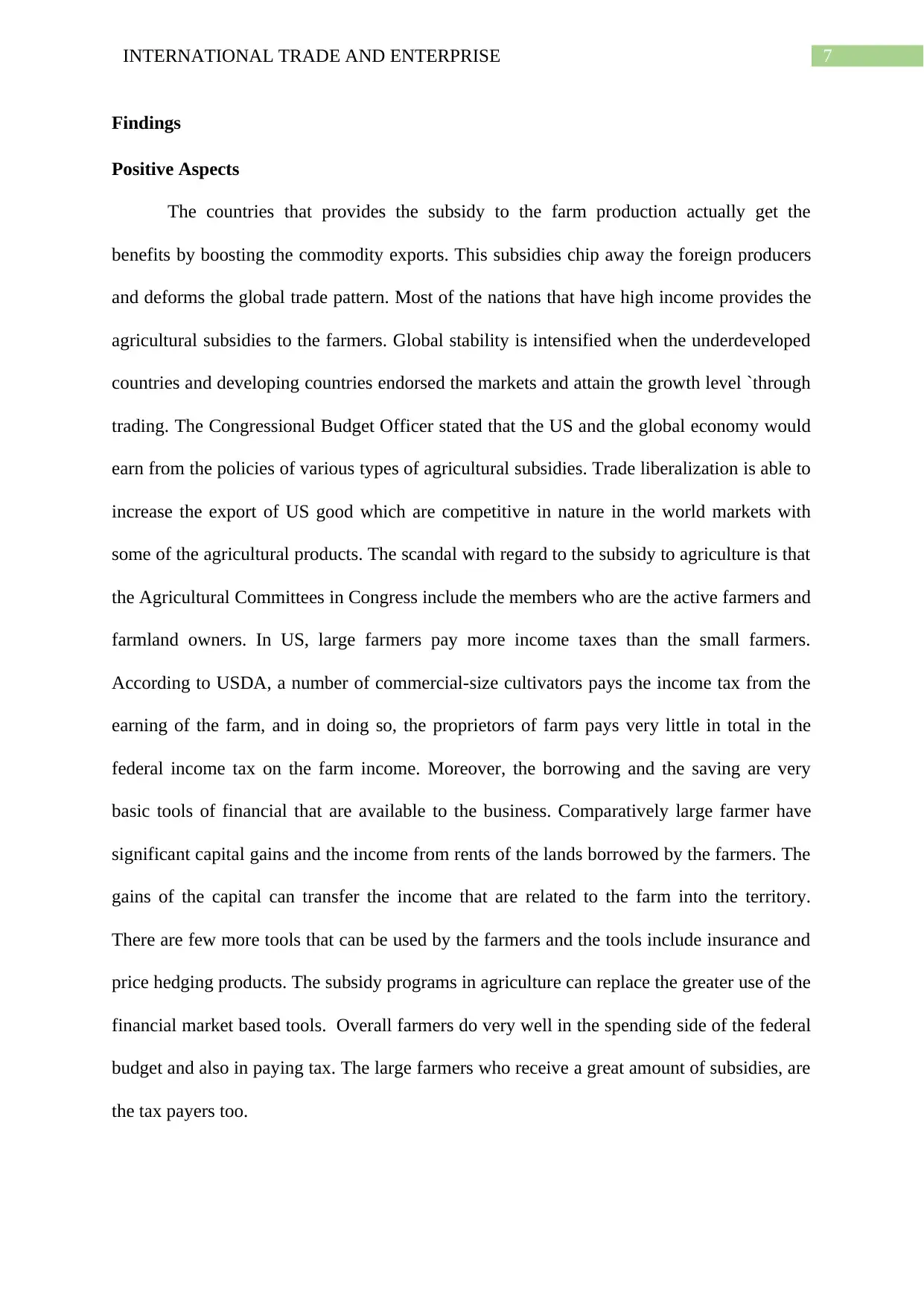
7INTERNATIONAL TRADE AND ENTERPRISE
Findings
Positive Aspects
The countries that provides the subsidy to the farm production actually get the
benefits by boosting the commodity exports. This subsidies chip away the foreign producers
and deforms the global trade pattern. Most of the nations that have high income provides the
agricultural subsidies to the farmers. Global stability is intensified when the underdeveloped
countries and developing countries endorsed the markets and attain the growth level `through
trading. The Congressional Budget Officer stated that the US and the global economy would
earn from the policies of various types of agricultural subsidies. Trade liberalization is able to
increase the export of US good which are competitive in nature in the world markets with
some of the agricultural products. The scandal with regard to the subsidy to agriculture is that
the Agricultural Committees in Congress include the members who are the active farmers and
farmland owners. In US, large farmers pay more income taxes than the small farmers.
According to USDA, a number of commercial-size cultivators pays the income tax from the
earning of the farm, and in doing so, the proprietors of farm pays very little in total in the
federal income tax on the farm income. Moreover, the borrowing and the saving are very
basic tools of financial that are available to the business. Comparatively large farmer have
significant capital gains and the income from rents of the lands borrowed by the farmers. The
gains of the capital can transfer the income that are related to the farm into the territory.
There are few more tools that can be used by the farmers and the tools include insurance and
price hedging products. The subsidy programs in agriculture can replace the greater use of the
financial market based tools. Overall farmers do very well in the spending side of the federal
budget and also in paying tax. The large farmers who receive a great amount of subsidies, are
the tax payers too.
Findings
Positive Aspects
The countries that provides the subsidy to the farm production actually get the
benefits by boosting the commodity exports. This subsidies chip away the foreign producers
and deforms the global trade pattern. Most of the nations that have high income provides the
agricultural subsidies to the farmers. Global stability is intensified when the underdeveloped
countries and developing countries endorsed the markets and attain the growth level `through
trading. The Congressional Budget Officer stated that the US and the global economy would
earn from the policies of various types of agricultural subsidies. Trade liberalization is able to
increase the export of US good which are competitive in nature in the world markets with
some of the agricultural products. The scandal with regard to the subsidy to agriculture is that
the Agricultural Committees in Congress include the members who are the active farmers and
farmland owners. In US, large farmers pay more income taxes than the small farmers.
According to USDA, a number of commercial-size cultivators pays the income tax from the
earning of the farm, and in doing so, the proprietors of farm pays very little in total in the
federal income tax on the farm income. Moreover, the borrowing and the saving are very
basic tools of financial that are available to the business. Comparatively large farmer have
significant capital gains and the income from rents of the lands borrowed by the farmers. The
gains of the capital can transfer the income that are related to the farm into the territory.
There are few more tools that can be used by the farmers and the tools include insurance and
price hedging products. The subsidy programs in agriculture can replace the greater use of the
financial market based tools. Overall farmers do very well in the spending side of the federal
budget and also in paying tax. The large farmers who receive a great amount of subsidies, are
the tax payers too.
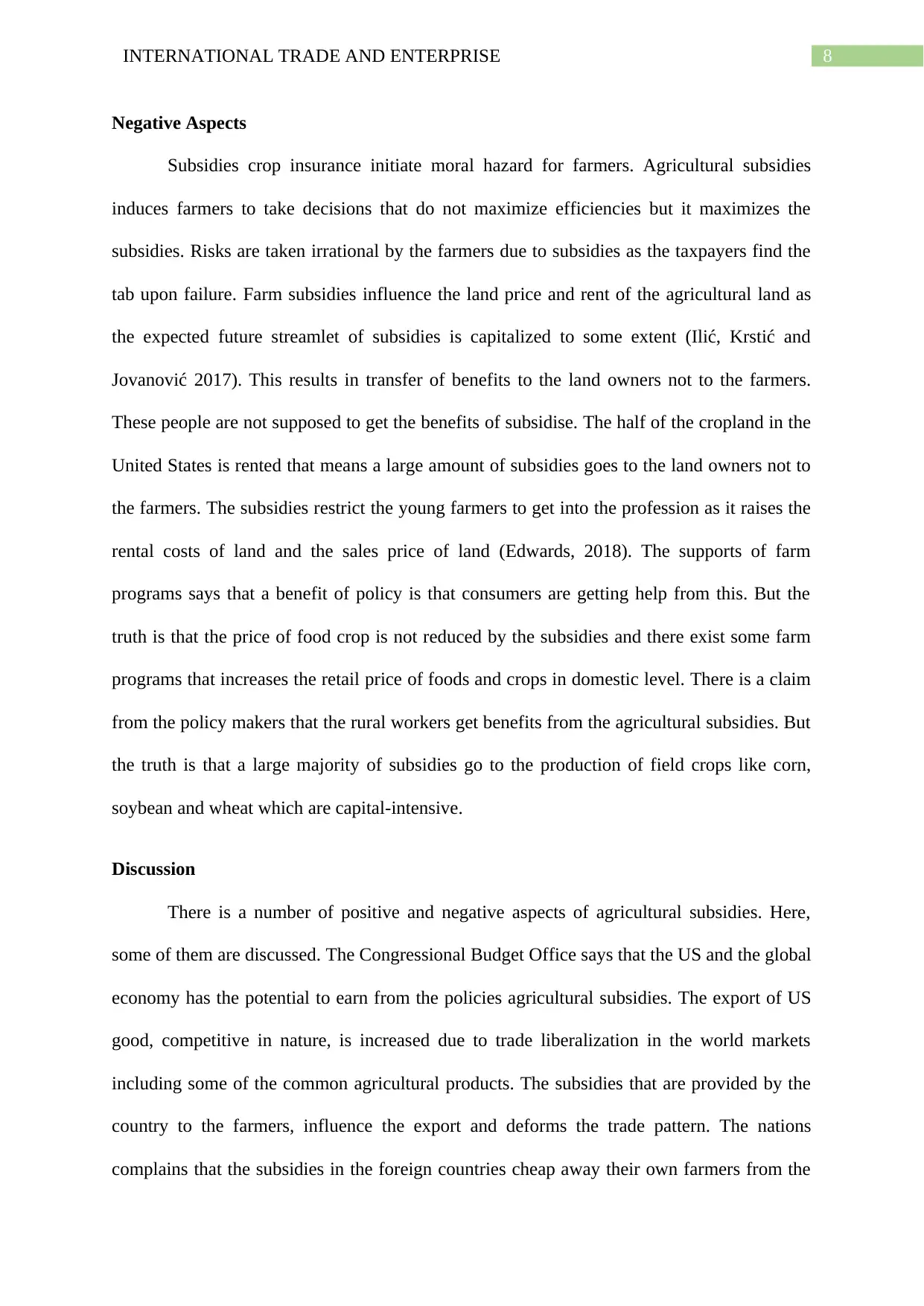
8INTERNATIONAL TRADE AND ENTERPRISE
Negative Aspects
Subsidies crop insurance initiate moral hazard for farmers. Agricultural subsidies
induces farmers to take decisions that do not maximize efficiencies but it maximizes the
subsidies. Risks are taken irrational by the farmers due to subsidies as the taxpayers find the
tab upon failure. Farm subsidies influence the land price and rent of the agricultural land as
the expected future streamlet of subsidies is capitalized to some extent (Ilić, Krstić and
Jovanović 2017). This results in transfer of benefits to the land owners not to the farmers.
These people are not supposed to get the benefits of subsidise. The half of the cropland in the
United States is rented that means a large amount of subsidies goes to the land owners not to
the farmers. The subsidies restrict the young farmers to get into the profession as it raises the
rental costs of land and the sales price of land (Edwards, 2018). The supports of farm
programs says that a benefit of policy is that consumers are getting help from this. But the
truth is that the price of food crop is not reduced by the subsidies and there exist some farm
programs that increases the retail price of foods and crops in domestic level. There is a claim
from the policy makers that the rural workers get benefits from the agricultural subsidies. But
the truth is that a large majority of subsidies go to the production of field crops like corn,
soybean and wheat which are capital-intensive.
Discussion
There is a number of positive and negative aspects of agricultural subsidies. Here,
some of them are discussed. The Congressional Budget Office says that the US and the global
economy has the potential to earn from the policies agricultural subsidies. The export of US
good, competitive in nature, is increased due to trade liberalization in the world markets
including some of the common agricultural products. The subsidies that are provided by the
country to the farmers, influence the export and deforms the trade pattern. The nations
complains that the subsidies in the foreign countries cheap away their own farmers from the
Negative Aspects
Subsidies crop insurance initiate moral hazard for farmers. Agricultural subsidies
induces farmers to take decisions that do not maximize efficiencies but it maximizes the
subsidies. Risks are taken irrational by the farmers due to subsidies as the taxpayers find the
tab upon failure. Farm subsidies influence the land price and rent of the agricultural land as
the expected future streamlet of subsidies is capitalized to some extent (Ilić, Krstić and
Jovanović 2017). This results in transfer of benefits to the land owners not to the farmers.
These people are not supposed to get the benefits of subsidise. The half of the cropland in the
United States is rented that means a large amount of subsidies goes to the land owners not to
the farmers. The subsidies restrict the young farmers to get into the profession as it raises the
rental costs of land and the sales price of land (Edwards, 2018). The supports of farm
programs says that a benefit of policy is that consumers are getting help from this. But the
truth is that the price of food crop is not reduced by the subsidies and there exist some farm
programs that increases the retail price of foods and crops in domestic level. There is a claim
from the policy makers that the rural workers get benefits from the agricultural subsidies. But
the truth is that a large majority of subsidies go to the production of field crops like corn,
soybean and wheat which are capital-intensive.
Discussion
There is a number of positive and negative aspects of agricultural subsidies. Here,
some of them are discussed. The Congressional Budget Office says that the US and the global
economy has the potential to earn from the policies agricultural subsidies. The export of US
good, competitive in nature, is increased due to trade liberalization in the world markets
including some of the common agricultural products. The subsidies that are provided by the
country to the farmers, influence the export and deforms the trade pattern. The nations
complains that the subsidies in the foreign countries cheap away their own farmers from the
⊘ This is a preview!⊘
Do you want full access?
Subscribe today to unlock all pages.

Trusted by 1+ million students worldwide
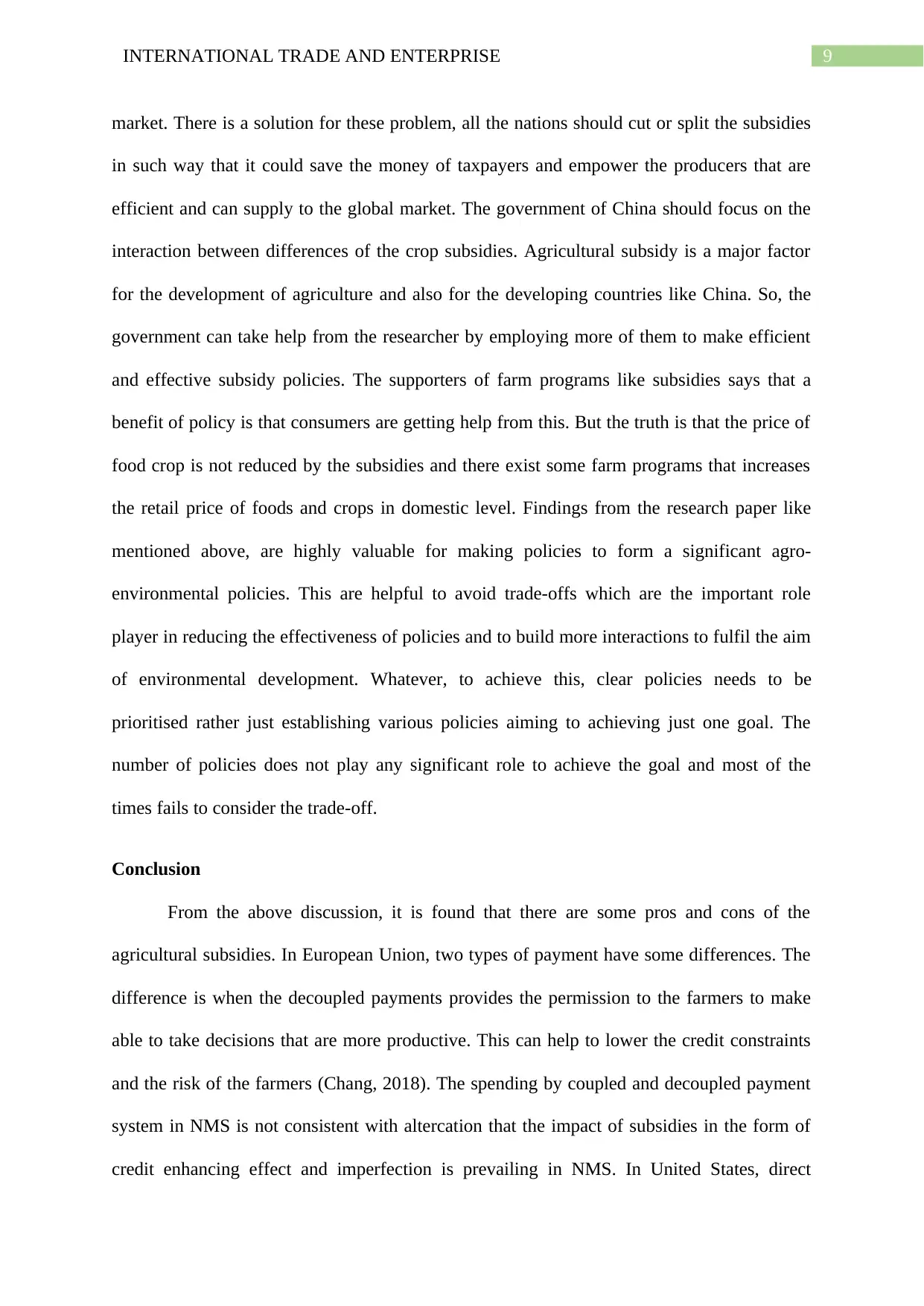
9INTERNATIONAL TRADE AND ENTERPRISE
market. There is a solution for these problem, all the nations should cut or split the subsidies
in such way that it could save the money of taxpayers and empower the producers that are
efficient and can supply to the global market. The government of China should focus on the
interaction between differences of the crop subsidies. Agricultural subsidy is a major factor
for the development of agriculture and also for the developing countries like China. So, the
government can take help from the researcher by employing more of them to make efficient
and effective subsidy policies. The supporters of farm programs like subsidies says that a
benefit of policy is that consumers are getting help from this. But the truth is that the price of
food crop is not reduced by the subsidies and there exist some farm programs that increases
the retail price of foods and crops in domestic level. Findings from the research paper like
mentioned above, are highly valuable for making policies to form a significant agro-
environmental policies. This are helpful to avoid trade-offs which are the important role
player in reducing the effectiveness of policies and to build more interactions to fulfil the aim
of environmental development. Whatever, to achieve this, clear policies needs to be
prioritised rather just establishing various policies aiming to achieving just one goal. The
number of policies does not play any significant role to achieve the goal and most of the
times fails to consider the trade-off.
Conclusion
From the above discussion, it is found that there are some pros and cons of the
agricultural subsidies. In European Union, two types of payment have some differences. The
difference is when the decoupled payments provides the permission to the farmers to make
able to take decisions that are more productive. This can help to lower the credit constraints
and the risk of the farmers (Chang, 2018). The spending by coupled and decoupled payment
system in NMS is not consistent with altercation that the impact of subsidies in the form of
credit enhancing effect and imperfection is prevailing in NMS. In United States, direct
market. There is a solution for these problem, all the nations should cut or split the subsidies
in such way that it could save the money of taxpayers and empower the producers that are
efficient and can supply to the global market. The government of China should focus on the
interaction between differences of the crop subsidies. Agricultural subsidy is a major factor
for the development of agriculture and also for the developing countries like China. So, the
government can take help from the researcher by employing more of them to make efficient
and effective subsidy policies. The supporters of farm programs like subsidies says that a
benefit of policy is that consumers are getting help from this. But the truth is that the price of
food crop is not reduced by the subsidies and there exist some farm programs that increases
the retail price of foods and crops in domestic level. Findings from the research paper like
mentioned above, are highly valuable for making policies to form a significant agro-
environmental policies. This are helpful to avoid trade-offs which are the important role
player in reducing the effectiveness of policies and to build more interactions to fulfil the aim
of environmental development. Whatever, to achieve this, clear policies needs to be
prioritised rather just establishing various policies aiming to achieving just one goal. The
number of policies does not play any significant role to achieve the goal and most of the
times fails to consider the trade-off.
Conclusion
From the above discussion, it is found that there are some pros and cons of the
agricultural subsidies. In European Union, two types of payment have some differences. The
difference is when the decoupled payments provides the permission to the farmers to make
able to take decisions that are more productive. This can help to lower the credit constraints
and the risk of the farmers (Chang, 2018). The spending by coupled and decoupled payment
system in NMS is not consistent with altercation that the impact of subsidies in the form of
credit enhancing effect and imperfection is prevailing in NMS. In United States, direct
Paraphrase This Document
Need a fresh take? Get an instant paraphrase of this document with our AI Paraphraser
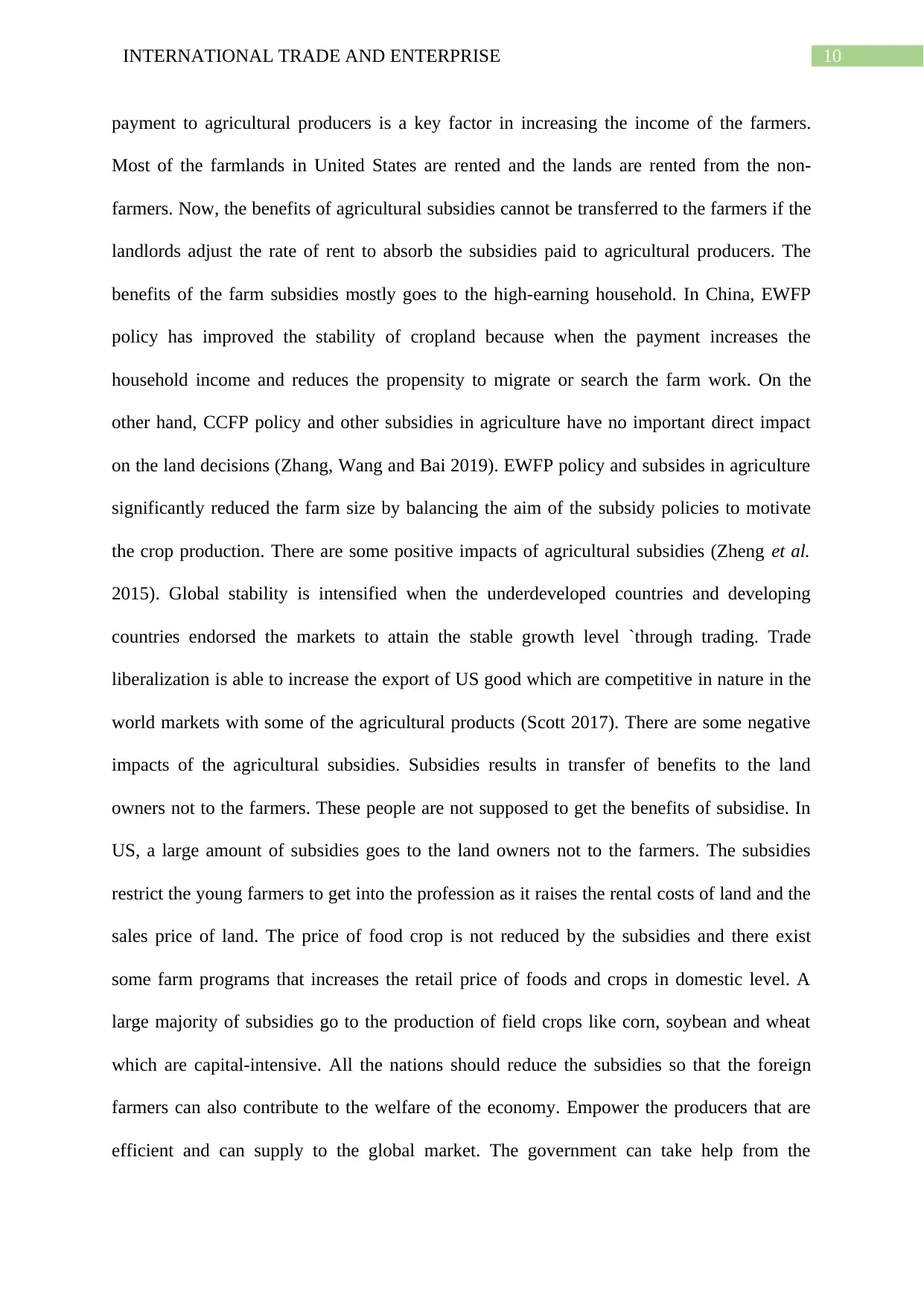
10INTERNATIONAL TRADE AND ENTERPRISE
payment to agricultural producers is a key factor in increasing the income of the farmers.
Most of the farmlands in United States are rented and the lands are rented from the non-
farmers. Now, the benefits of agricultural subsidies cannot be transferred to the farmers if the
landlords adjust the rate of rent to absorb the subsidies paid to agricultural producers. The
benefits of the farm subsidies mostly goes to the high-earning household. In China, EWFP
policy has improved the stability of cropland because when the payment increases the
household income and reduces the propensity to migrate or search the farm work. On the
other hand, CCFP policy and other subsidies in agriculture have no important direct impact
on the land decisions (Zhang, Wang and Bai 2019). EWFP policy and subsides in agriculture
significantly reduced the farm size by balancing the aim of the subsidy policies to motivate
the crop production. There are some positive impacts of agricultural subsidies (Zheng et al.
2015). Global stability is intensified when the underdeveloped countries and developing
countries endorsed the markets to attain the stable growth level `through trading. Trade
liberalization is able to increase the export of US good which are competitive in nature in the
world markets with some of the agricultural products (Scott 2017). There are some negative
impacts of the agricultural subsidies. Subsidies results in transfer of benefits to the land
owners not to the farmers. These people are not supposed to get the benefits of subsidise. In
US, a large amount of subsidies goes to the land owners not to the farmers. The subsidies
restrict the young farmers to get into the profession as it raises the rental costs of land and the
sales price of land. The price of food crop is not reduced by the subsidies and there exist
some farm programs that increases the retail price of foods and crops in domestic level. A
large majority of subsidies go to the production of field crops like corn, soybean and wheat
which are capital-intensive. All the nations should reduce the subsidies so that the foreign
farmers can also contribute to the welfare of the economy. Empower the producers that are
efficient and can supply to the global market. The government can take help from the
payment to agricultural producers is a key factor in increasing the income of the farmers.
Most of the farmlands in United States are rented and the lands are rented from the non-
farmers. Now, the benefits of agricultural subsidies cannot be transferred to the farmers if the
landlords adjust the rate of rent to absorb the subsidies paid to agricultural producers. The
benefits of the farm subsidies mostly goes to the high-earning household. In China, EWFP
policy has improved the stability of cropland because when the payment increases the
household income and reduces the propensity to migrate or search the farm work. On the
other hand, CCFP policy and other subsidies in agriculture have no important direct impact
on the land decisions (Zhang, Wang and Bai 2019). EWFP policy and subsides in agriculture
significantly reduced the farm size by balancing the aim of the subsidy policies to motivate
the crop production. There are some positive impacts of agricultural subsidies (Zheng et al.
2015). Global stability is intensified when the underdeveloped countries and developing
countries endorsed the markets to attain the stable growth level `through trading. Trade
liberalization is able to increase the export of US good which are competitive in nature in the
world markets with some of the agricultural products (Scott 2017). There are some negative
impacts of the agricultural subsidies. Subsidies results in transfer of benefits to the land
owners not to the farmers. These people are not supposed to get the benefits of subsidise. In
US, a large amount of subsidies goes to the land owners not to the farmers. The subsidies
restrict the young farmers to get into the profession as it raises the rental costs of land and the
sales price of land. The price of food crop is not reduced by the subsidies and there exist
some farm programs that increases the retail price of foods and crops in domestic level. A
large majority of subsidies go to the production of field crops like corn, soybean and wheat
which are capital-intensive. All the nations should reduce the subsidies so that the foreign
farmers can also contribute to the welfare of the economy. Empower the producers that are
efficient and can supply to the global market. The government can take help from the
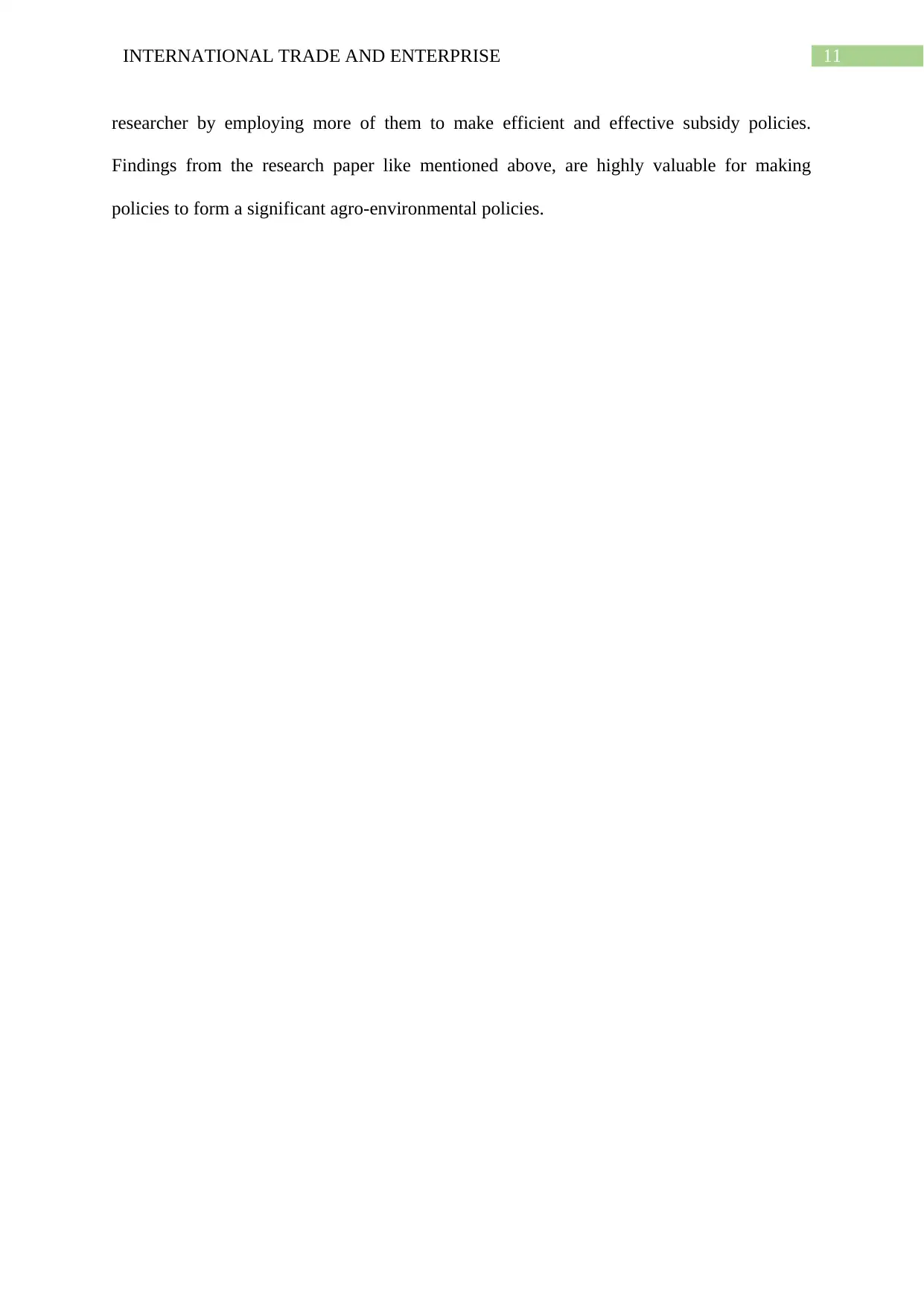
11INTERNATIONAL TRADE AND ENTERPRISE
researcher by employing more of them to make efficient and effective subsidy policies.
Findings from the research paper like mentioned above, are highly valuable for making
policies to form a significant agro-environmental policies.
researcher by employing more of them to make efficient and effective subsidy policies.
Findings from the research paper like mentioned above, are highly valuable for making
policies to form a significant agro-environmental policies.
⊘ This is a preview!⊘
Do you want full access?
Subscribe today to unlock all pages.

Trusted by 1+ million students worldwide
1 out of 15
Related Documents
Your All-in-One AI-Powered Toolkit for Academic Success.
+13062052269
info@desklib.com
Available 24*7 on WhatsApp / Email
![[object Object]](/_next/static/media/star-bottom.7253800d.svg)
Unlock your academic potential
Copyright © 2020–2025 A2Z Services. All Rights Reserved. Developed and managed by ZUCOL.





